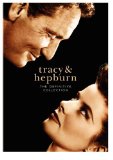| Reviews & Columns |
|
Reviews DVD TV on DVD Blu-ray 4K UHD International DVDs In Theaters Reviews by Studio Video Games Features Collector Series DVDs Easter Egg Database Interviews DVD Talk Radio Feature Articles Columns Anime Talk DVD Savant Horror DVDs The M.O.D. Squad Art House HD Talk Silent DVD
|
DVD Talk Forum |
|
|
| Resources |
|
DVD Price Search Customer Service #'s RCE Info Links |
|
Columns
|
|
|
Tracy & Hepburn: The Definitive Collection
Along with Fred Astaire and Ginger Rogers, Spencer Tracy and Katharine Hepburn are easily the most distinguished and accomplished acting duo, leaving a legacy of nine films over the course of 25 years. Initially pairing up in 1942's "Woman of the Year," Hepburn, worried she was too tall for Tracy, was assured by the film's producer that Tracy would "cut her down to size." Little did anyone know that the two would continue a steady working relationship on-screen as well as an infamous off-screen affair that would have probably culminated in marriage, if Tracy's Catholic background didn't stop him from divorcing his wife.
Consumate professionals in every film, regardless of what was going on behind-the-scenes (Tracy's drinking, the two on the outs, Tracy's health issues, you name it), the two tackled not only romantic comedies, including the absolutely perfect "Adam's Rib" and "Pat and Mike," but also the culturally significant swansong, "Guess Who's Coming to Dinner" (Tracy would earn a posthumous Best Actor nomination, while Hepburn would take home the gold for her role) as well as a few genre diversions, such as the mystery "Keeper of the Flame" and "Sea of Grass." While not every film was a smash success, even at their lowest, Hepburn and Tracy were still well above average. Their on-screen chemistry was lightning in a bottle and it's safe to say, no duo will ever replicate what the two had in so many films, with such consistency.
Warner has finally released all nine collaborations in one handy set, going as far as to license "State of the Union" from Universal, "Desk Set" from Fox, and "Guess Who's Coming to Dinner" from Sony. In addition, "Keeper of the Flame" and "Sea of Grass," the two "missing" films make their way to DVD for the first time (they've also been released separately). While all the DVDs are re-releases of existing discs, the set is a nice one-stop shopping way of collecting some outstanding films, even if you already own a few.
THE FILMS
WOMAN OF THE YEAR
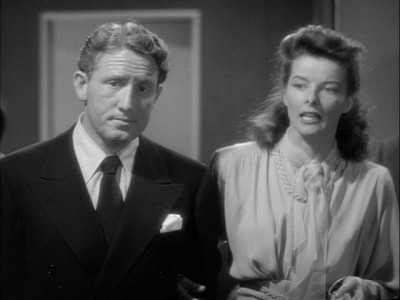
1942's "Woman of the Year" was the first time the immortal duo of Tracy and Hepburn would find themselves paired together on screen. While it's easily one of the first titles your average film fan will mention associated with the pair, it's also a film that's been viewed through rose-colored glasses for nearly 70 years. Directed by George Stevens from a script enlisting four writers, "Woman of the Year" is often falsely attributed as being a romantic comedy, and while there are laughs to be had, viewing it solely as an entry in this genre is a huge misnomer.
Hepburn plays confident, self-assured political writer Tess Harding, whose career is very casually implied to have been aided by her father's standing as a diplomat. In typical opposites attract formula, Tess meets fellow writer, Sam Craig (Tracy), a kind, hardworking sports-writer and through your typical "worlds collide" and "love blossoms" fashion, Tess and Sam get married. It's here where the comedy leaves "Woman of the Year" and not too long after the romance is hightailing it for greener pastures.
On the surface Stevens' direction appears to make a political and social statement regarding the independent working woman and her ability to keep up such a life after marriage, but every time the issue is addressed in the movie, the director does his best to make Tess come off as unpleasant, condescending or a combination. Stevens isn't entirely to blame though, as the inherent jabs at the working, educated woman is peppered throughout the movie, the most blatant example being Tess' whimsical adoption of a young Greek boy without consulting Sam, who is expected to care for the child as Tess whisks off to a career related obligation.
It's only through the immense talents of Tracy and Hepburn that both characters are somewhat likeable and the film itself comes off as being much better than it actually is. Hepburn adds a great level of pathos to her character and in the film's final act where the veiled misogyny of the movie becomes most apparent, she refuses to succumb fully to her character's degeneration into the mindless housewife stereotype, subtly interjecting little character ticks into her movements and behavior letting viewers know her heart is torn between two worlds. Tracy is left with far less to do in the film than one would expect and is often tasked with reacting to the behavior of others, which he does quite well. The viewer is expected to feel sympathetic for him, but he doesn't feel as fully fleshed out a character as his counterpart.
"Woman of the Year" is still a far more than competent film and Stevens keeps an overly long (nearly two hours total) film going at a steady pace, with the film's last minute physical comedy routine winding up as a double edged sword: on one hand it definitely gets your attention, while on the other it's little more than a collection of broad stereotypes casually trying to tell the audience that Tess is a failure as a woman. I may very well have read more into "Woman of the Year" than intended, but from a modern perspective, it's far from Tracy and Hepburn's best work and should be viewed primarily more as a historical document of the first meeting of two great minds and secondly as a slightly above average romantic dramedy.
MOVIE: 3.5/5.0
REPLAY: 3.0/5.0
KEEPER OF THE FLAME
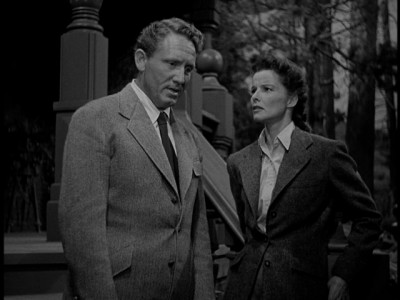
George Cukor's "Keeper of the Flame" is a product of its time that fails to resonate with modern audiences. Bringing Hepburn and Tracy together for a second time, Cukor works off a shockingly dull script from Donald Ogden Stewart, who brought us one of the most sharply written comedies of all time, "The Philadelphia Story." On the surface "Keeper of the Flame" is "Citizen Kane" knock-off, which I hesitate to slap with the adjective "poor man's" because Cukor's direction, while failing to reach the genius of Welles' is still incredibly gripping, given what little there is to work with.
Tracy shoulders the weight of the film as journalist Stephen O'Malley, who is sent to cover the mysterious death of Robert Forrest, a wealthy industrialist seemingly beloved by the entire country. Like in "Citizen Kane" a great portion of the film revolves around the reporter's quest in gaining insight into Forrest, the man and the circumstances revolving around his death. Cukor weaves a fog of mystery and a feeling of something unsettling far in the distance, as O'Malley searches for a way to get the most critical interview of all, with Forrest's reclusive wife Christine (Hepburn).
Unfortunately, 90% of "Keeper of the Flame" is buildup to a reveal that at the time would have been shocking and terrifying, but now is merely mundane. Cukor's attempts to keep the tension ratcheted up fall apart not long before the audience gets its payoff, mostly after O'Malley visits Forrest's cartoonishly insane mother, whose vague proclamations is sure to garner a chuckle or two. Further complicating matters is Tracy, who by and large, phones his role in. It's been revealed in the decades that followed "Keeper of the Flame" was a troubled production with Tracy drinking heavily and the usually spot-on actor is obviously doing his best to just get through some scenes. On the plus side of these troubles, the off-screen relationship between Hepburn and Tracy had grown as a result of Hepburn looking after her co-star, and when the two finally meet on-screen, the chemistry between them feels rushed, but wholeheartedly genuine. Had their been more of it, "Keeper of the Flame" would have been a better film.
I refuse to hold the film's now mundane ending against it and viewed as a product of its times, "Keeper of the Flame" is a successful, but largely uninspired thriller. It's the most disappointing pairing of Hepburn and Tracy, and only Cukor escapes with the most positive praise, doing the best with what he had. Plain and simple, "Keeper of the Flame" is just another above-average film that feels more dreadful given the talent involved in its creation.
MOVIE: 3.0/5.0
REPLAY: 2.0/5.0
WITHOUT LOVE
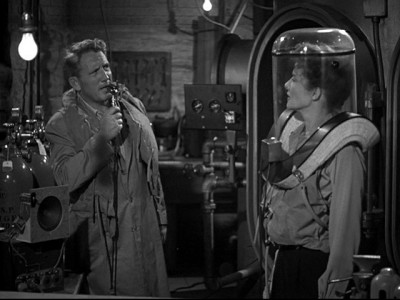
"Without Love" is easily the most simple of the Tracy and Hepburn collaborations. Their third film together, it's words come from the familiar pen of Donald Ogden Stewart and while it's no "Philadelphia Story" it's far more of a crowd pleaser than the dry "Keeper of the Flame." As audiences would realize in future pairings, the characters Tracy and Hepburn embody are introduced rather quickly as intellectual equals and in turn, the romantic comedy format of the film is given a novel twist. Opposites in previous romances, Tracy is government scientist Patrick Jamieson, who rents out the lonely basement of Jamie Rowan's (Katharine Hepburn) stately manor. As expected, the two meet at odds, but quickly through mirrored scenes, dominate the conversation and share their thoughts on love. Cutting to the chase, Jamie, either not realizing or not wanting to admit her instant attraction to Pat, proposes marriage and without really thinking the equally smitten, but repressed Pat accepts.
Where Jamie and Patrick find equal ground is in Patrick's research, which Jamie knows a thing or two about due to her father's past as a research scientist. Stewart's script never expands on the possible idea that Jamie might be searching for a father figure in her life and instead, plays up the obvious idea that the romantic duo has cut to the chase and before it's all over, own up to their hidden feelings for each other. On the flipside, supporting players Keenan Wynn and Lucille Ball have the opposite problem, as Quentin and Kitty respectively, with Wynn providing some great broad comic moments as Pat's drunken colleague and Kitty, in a turn that is very much now against type of Lucille Ball is in many ways the straight woman of the film.
If there's one major fault in "Without Love" is there's not a lot of substance and at times viewers may struggle with the notion the more low key Pat and Jamie are the focal points of the film, rather than the more animated, genre fitting Kitty and Quentin. Additionally, the script isn't as sharp as latter Hepburn and Tracy films and director Harold S. Bucquet, who had worked a year prior with Hepburn in the notorious "Dragon Seed" often seems resigned to the fact he can just point his camera at the legendary duo and let the magic unfold. Thankfully, the on-screen talents combined with the real off-screen romance between Hepburn and Tracy is for the first time in film history the most realized and watching the two work together and against each other is the real highlight of the film.
"Without Love" is a very good film that may initially give the impression of being a lesser film, simply due to its minimalist feel. The fact remains though, that it is a very good film for this reason alone. It's the appetizer of things to come from the Hepburn and Tracy duo for film fans in the form of a pleasantly enjoyable, sweet twist on the romantic comedy. It might not be a film you bring out to watch as often as say, "Pat and Mike" or "Adam's Rib," but when you do, you'll be left with a big smile on your face.
MOVIE: 4.0/5.0
REPLAY: 3.5/5.0
SEA OF GRASS
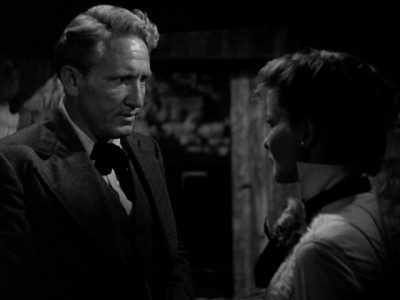
Elia Kazan's second feature film, "The Sea of Grass," based off the novel of the same title is truly the odd man out in the Hepburn and Tracy catalog. A melodrama painted in Western colors, it's likely most notable for being the one film Kazan claimed he was ashamed to have made and advised people not to see. Now, 64 years later, along with "Keeper of the Flame," it's one of the final Hepburn and Tracy films to make it to DVD, and to be honest, while it's by no means one of Kazan's best films and has its share of issues, it's still a very fascinating piece of cinema.
Col. Jim Brewerton is a man of a dying breed, tasked with protecting the pristine prairie lands, or the titular "sea of grass" as his wife, Lutie (Hepburn) described it. Brewerton sees the coming influx of pioneers as death for the fertile land and with the death of the land, the livelihoods of the ranchers that have staked their claim year's prior are at risk. Complicating his mission of vigilance, which often involves brute, lethal force to keep would be settlers away, Brewerton is tasked with keeping his St. Louis bred and born wife happy in the much more low-key world of the New Mexican plains. Seeing Lutie's unhappiness with country life, Brice Chamberlain (Melvyn Douglas) a local rival of Brewerton sets his sights on Lutie and it's not long before an affair is consummated and the fresh marriage of Lutie and Brewerton is quietly damaged.
While it wholly sounds like a recipe for a gripping Western melodrama, the fundamental flaw in "The Sea of Grass" is the directionless pacing. Kazan turns in a handsome looking, technically sound film, but when it comes to pacing and logical low, and "The Sea of Grass" is constantly stumbling over its feet. Running a slow 125 minutes, the set-up described above takes nearly half the runtime to unfold and at that point Kazan launches the story into a series of subtle jumps in time that can easily confuse and lose viewers, who miss passing references to the age of Lutie and Brewerton's children Sara Beth and Brock, the latter of which may very well be the offspring of Chamberlain. Making matters worse, Brewerton who should be a sympathetic figure at this point in the story, after all his wife cheated on him for selfish reasons is crafted into a nearly silent, cruel bastard who uses his own daughter as a means to punish Lutie. Forced with exile with or without her son, Lutie sets off on a quest to fix her broken marriage and the film clumsily advances years as Brock (played by Robert Walker as an adult) not only receives Brewerton's attentions, but also seems to adopt his violent nature for handling problems.
Kazan's warning to audiences does hold merit as "The Sea of Grass" enters it's final act. It becomes a confusing, upsetting film with the audience not really knowing who to pity, although Sara Beth, the tragic pawn in most of the mess is probably the only safe bet. Tracy and Hepburn don't shoulder any of the blame as their performances are strong as usual, although both are much quieter than expected. Tracy does turn in the weaker portrayal, never quite convincingly embodying the silent military man, while Hepburn is fascinating as the outwardly quiet, often meek housewife, whose own internal snobbery is the genesis of the melodramatic conflict that spans many years.
"The Sea of Grass" isn't an awful film; for a Western melodrama it's far more tolerable and watchable than expected, but the disappointment of it's merely above-average status given it's roots as a Elia Kazan directed, Tracy and Hepburn vehicle makes the sour parts sting just a little bit more. Not as disappointing or dull as "Keeper of the Flame," but a close runner up.
MOVIE: 3.5/5.0
REPLAY: 2.5/5.0
STATE OF THE UNION
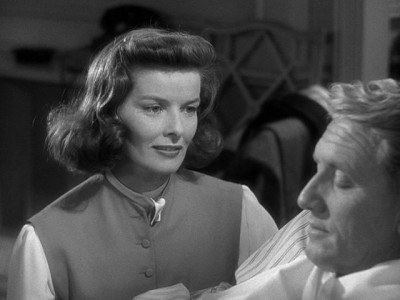
Frank Capra's "State of the Union" was nearly the Katharine Hepburn and Spencer Tracy film that almost wasn't. Originally cast in the lead actress role, Claudette Colbert left the production for reasons never fully nailed down, and it was Tracy's suggestion to Capra that resulted in the fifth collaboration between the two actors. The film, based off the hit play of the same name, chronicles the backstage machinations of the political scene, as newspaper heir, Kay Thorndike (Angela Lansbury) seeks to install her free-spirited, corporate tycoon boyfriend, Grant Matthews as President of the United States. This comes with two big snags for Thorndike in the form of Grant's stubborn idealism and his estranged wife, Mary (Hepburn).
Stemming from a stage origin, "State of the Union" is by default very wordy and static, so it falls on the shoulders of the great cast to keep things running and Capra's supporting players are all heavyweights in their own right. Rounding out Thorndike's cabal of campaigners are Van Johnson and Adolphe Menjou as manager Spike McManus and strategist Jim Conover, respectively. While Conover, primarily seeks to corrupt and bend the earnest Grant to lobbyists (yep, they had 'em in '48) and the goals of Thorndike, Mary is the perennial thorn in everyone's side.
Hepburn's portrayal of Mary acts as not only the moral compass of our protagonist but also as the proxy of every good-hearted American who wants to believe in the system and believe in someone in power to look up to. She overlooks the flaws of Grant, including his affair with Thorndike, because she believes in his spirit and his love for his country. Capra throws in a scene, which I can't imagine being in a stage play (or at least not a quarter as effective), where Grant, an aircraft magnate to be specific lets his rebellious, stubborn streak take over and engages in a very fun wagered race against another pilot. When the pilot appears to get the upper hand on Grant, he quite literally throws caution to the wind and we see what Mary sees in him, as well as how much she still cares.
"State of the Union" is a little heavy at a hair over two hours and Capra's patriotism gets slapped on a bit heavy in the final 30-minutes, with all the major themes of the film hitting viewers quick and heavy, in case they didn't pick up on them before. It's very much an idealistic film, given the nature of the hero, but there are a few twists and turns, that given the nature of politics and it's affect on good men, will make the ending unpredictable. In the traditional sense, it's one of the few Hepburn and Tracy collaborations where the film doesn't seem to be built around the duo, instead it utilizes that famous chemistry as a foundation, resulting in a low-key (for the star power involved) film performance wise, with the ideas taking the spotlight.
MOVIE: 4.0/5.0
REPLAY: 3.5/5.0
ADAM'S RIB
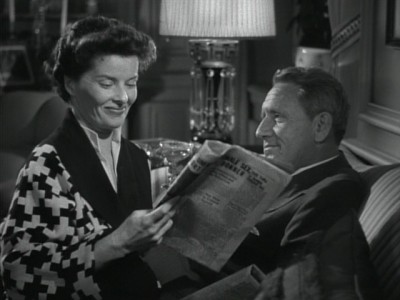
The first of two, absolutely perfect films from a pairing of Katharine Hepburn and Spencer Tracy, "Adam's Rib" is a courtroom film that examines the effect a high profile, battle-of-the-sexes case has on Adam (Tracy) and Amanda Bonner (Hepburn), district attorney and defense attorney respectively. Amanda sets the ensuing war into motion, when she decides to defend Doris Attinger (Judy Holliday) against an assault charge of shooting her philandering husband, Warren (Tom Ewell) in the shoulder. With Adam in charge of trying what should be an open-and-shut case, Amanda decides to defend not only Doris, but also the female gender.
Based on a script by team of Ruth Gordon and Garson Kanin, married in real-life, it should come as no shock that "Adam's Rib" pulls no punches when it comes to men versus women, while retaining a genuine sense of love and affection. Directed by George Cukor, the film spends a great deal of time establishing the love Adam and Amanda have for each other: they initially head off to work, square off in the courtroom and return home, leaving their troubles behind them. An early party sequence brings out home movies of the two, while neighbor Kip (David Wayne) provides a humorous running commentary to the delight of guests. Knowing how much they care for each other does make the ensuing scuffle not just funny, as intended, but bittersweet and insightful.
As with every feud known to human history, Adam and Amanda eventually resort to increasingly over-the-top levels of one-upsmanship, and it's not long before everyone involved is more focused on their feud than the trial at hand. When one of Amanda's stunts goes too far, the repercussions are far reaching and the peaceful bliss of home life is a charade too tough to keep up. As expected, Hepburn and Tracy are magnificent and they handle the genuine affection as well as they handle the quarrels. Cukor's direction is at times non-existent, letting the two titans work their magic, bringing the consistently stellar script to life. "Adam's Rib" is one of those rare cinematic treats where no one scene can be pointed to as being the highlight of the film, instead it's a smartly crafted, solid ride from start to finish.
I have no reservations calling "Adam's Rib" a perfect film, because it's just that. There's an element of mystery and suspense, genuine drama and romance, and equal parts broad and intellectual comedy. The pacing is amazing and there's not a single point where the movie loses steam, effortlessly jumping between emotions, in no small part to the acting talents of it's leading couple. As a courtroom comedy, I'd only place it behind the more blunt "My Cousin Vinnie," if only because a lot of "Adam's Rib" takes place outside the courtroom (the case is wrapped up around the three-quarter mark), since at the core, the film is about the relationship between Adam and Amanda. As a romantic comedy, it's top tier material, rivaled by only a few films and is Hepburn and Tracy, in their primes and at their finest.
MOVIE: 5.0/5.0
REPLAY: 5.0/5.0
PAT AND MIKE
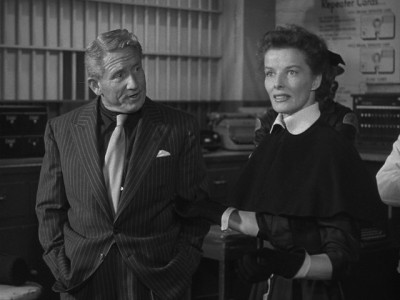
Spencer Tracy and Katharine Hepburn's final collaboration with director George Cukor would come in the 1952 pure comedy, "Pat and Mike," a script also the brainchild of writers Ruth Gordon and Garson Kanin. While Hepburn and Tracy don't have a lot of screen time together in the first third of the film, that doesn't keep the sharp dialogue and witty back-and-forth to a minimum as sportswoman Pat Pemberton (Hepburn) faces off against her soon-to-be husband, the patronizing Collier Weld (William Ching). Cukor never lets the audience catch their breath, swiftly carrying Pemberton through her journey from repressed future housewife to an independent athlete under the guise of three-quarter-time manager, one-quarter crook Mike Conovan (Tracy). The duo's initial meeting sets the pace for the relationship to follow that is on the surface platonic, but eventually sweetly sentimental.
Initially propositioned to throw a major golf championship, Pemberton flatly refuses Conovan's guaranteed opportunity to make a quick buck. The woman's unflinching character (and good looks) catches the eye and heart of Conovan who extends a genuine offer of legitimate management. It's not until Pemberton realizes how she's slowly inching towards being her well-meaning but pompous fiancée's puppet, that Pemberton strikes out on her own, joining Mike's cadre of talent: Nelly, a racehorse and Hucko (Aldo Ray), the film's only low-point, an oafish meat headed caricature of every vintage boxer. As fun as the film starts out, once Cukor gets the titular characters together, the audience gets more than their money's worth with snappy exchanges between manager and athlete (Mike's un-flummoxed retort to Pat's sarcastic invitation to burp her after she eats is a testament to the script's endless supply of gold, often casually dispensed as throwaway one-liners).
In the midst of the humor, Cukor gives the actors a chance to display their genuine affections for each other, and the few, wordless actions of Mike speaks volumes for how his character is becoming smitten with Pat. I challenge anyone to find a scene in a comedy that is as meaningful when Mike wipes the lipstick from his cheek, smiles at the handkerchief and then carefully folds it away in his wallet. On the same hand, Cukor doesn't allow the sentimentality to get to syrupy and a brief sequence where Pat and Mike visualize one another attached to the thing they love most at the moment is too funny to explain and criminal to spoil.
Only in the final moments of the film, does "Pat and Mike" feel like it might fall of the tracks, with Cukor slightly rushing the finale, turning in a 95-minue movie that is noticeably more compact than his other efforts, which were 10-20 minutes longer. The faithful will understand his reasoning, largely an effort to not rehash another extended sports sequence and in order to end the film on a satisfying, loving and smart note. "Pat and Mike" is plain and simple, one of those "they don't make 'em like they used to" films. Where else can you get the perfect on-screen combination of Spencer Tracy and Katherine Hepburn set in the world of athletics, that manages to have the female lead strike fear into the heart of Charles Bronson (yes, you read that right) and still have time to make some non-pandering statements about female empowerment and the fine line a man must walk in order to support but not smother the woman he loves?
MOVIE: 5.0/5.0
REPLAY: 5.0/5.0
DESK SET
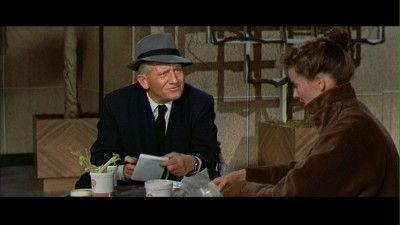
"Desk Set" is the penultimate film in the tandem pairing of Katherine Hepburn and Spencer Tracy. Released in 1957, it would mark the end of a fairly steady stream of films starring the duo, which would go on hiatus from one another for a decade. Directed by Walter Lang and adapted from a play by William Marchant, it had all the trappings of Hepburn and Tracy film, but was still a modern feeling film that didn't relegate it's supporting cast to set dressing. Hepburn would lead the film as FBN (a stand in for NBC) reference librarian, Bunny Watson. A confident, brilliant woman, Bunny led her efficient department with a trio of younger assistants: Ruthie (Sue Randall), Sylvia (Dina Merrill), and Bunny's close friend and confidant, Peg (Joan Blondell). Despite her age, Bunny was a hapless romantic engaged in a steady, but recently stagnating relationship with Mike Cutler (Gig Young), a hip executive at the station. Enter Richard Sumner (Tracy), a brilliant engineer who has the office awhirl in rumors with his computerized reference system, EMERAC.
"Desk Set" wisely plays to the classic Hepburn and Tracy chemistry, putting the two characters on equal ground intellectually, ignoring Richard's obvious height in the company compared to Bunny's important, but relatively low status. The initial meeting of the minds occurs over a casual lunch (Bunny's reaction to this is priceless) of roast beef sandwiches, as Richard tries to slyly prove his point regarding EMERAC by throwing a handful of classic logic puzzles, Bunny's way. Lang lets the camera linger on the pair, with Hepburn solving riddle after riddle and shivering in the cold, wholly perplexed why the puzzles are intended to be challenging, while Tracy's face steals the scene continually bouncing from smug confidence to agape astonishment and bewilderment. It's a classic moment between the two that reminds viewers why we loved the two so much.
The remainder of "Desk Set" is nothing to sneeze at, with the relationship between Bunny and Richard casually building, all while the façade of Bunny and Mike having a future rears its head for a few comedic confrontations. The film itself is solidly paced, establishing the obvious, then stepping back to bring our leads together for a few standout moments, filling the gaps with some great scenes between Bunny and her gals, including a drunken Christmas party where Tracy plays the role of the amused observer to the childish shenanigans of such professional women.
Some may find it odd that EMERAC doesn't show up until the end of the film, tying up the initial conflict between present and future set-up in the beginning, but it's for good reason. The final comedic set piece is a little outlandish, thoroughly entertaining, and lasts just long enough that the novelty value isn't lost. It's actually a bit of a groundbreaking moment in movie history, introducing the idea of computer being a villain (albeit here, it's just a threat to jobs), which would a popular sci-fi subject in years to come. Also worth noting is Neva Patterson who shows up with EMERAC as Miss Warriner, the giant machine's operator. It's a one-dimensional thankless role that Patterson slips into perfectly and is extremely memorable during her short screen time.
"Desk Set" comes close to completing a hat trick of "perfect" Hepburn and Tracy combinations, but falls a little short. Gig Young's role as the romantic rival feels like it comes and goes at a whim, while the eventual romance between Richard and Bunny is built pretty quickly and the payoff is arguably a little long coming. Quibbles aside, it's a fantastically fun motion picture that is a great send-off to the heyday of cinema's greatest on-screen duo; although the two would appear once more in "Guess Who's Coming to Dinner," they would never be as sharp on their feet or as vibrant with life as they were here.
MOVIE: 4.5/5.0
REPLAY: 4.5/5.0
GUESS WHO'S COMING TO DINNER
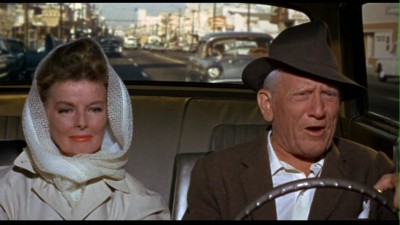
The final Spencer Tracy and Katharine Hepburn collaboration, "Guess Who's Coming to Dinner" is a film that will eternally hold a place in film history. Groundbreaking for it's political and social content, it's a simple story of a perfect (and I don't use the term lightly) African-American man, John Prentice, M.D. (Sidney Poitier) and his desire to marry the love his life, Joanna Drayton (Katharine Houghton, real life niece of Hepburn), the daughter of the very much white, very much liberal couple of Matt and Christina (Tracy and Hepburn respectively). The film, which builds up to the titular dinner, wherein both families will meet, is earnest and sincere, but is also incredibly heavy handed, idealistic, and contrived. However, as the final testament to the power of Hepburn and Tracy, it's a phenomenal film for reasons wholly unintended by director Stanley Kramer and writer William Rose.
I can vividly recall experiencing the film at a young age, decades after it's theatrical and heavy social relevance, and even at that young age, the story felt hokey. While no one can begin to make the argument that racism is dead in 2011, it's safe to say the times have definitely changed since 1967 and the idea that an interracial marriage, let alone one between two well-to-do parties is shocking or scandalous is laughable unto itself. Rose's script is at its worst as blunt and heavy handed as a caveman's club, but thankfully, while these moments definitely stop the film dead in its tracks, director Kramer has a brilliant cast to make this well intentioned, but bitter pill easier to swallow. Where Rose's script shines is the genuine love between Matt and Christina, who must come to grips that despite their liberal beliefs, the idea that their white daughter is marrying a black man is something that makes them take pause.
Their reservations are incredibly minor compared to those of Prentice's parents, played by Roy E. Glenn and Beah Richards, who fall tragically short in their believability against cinema's most genuine and accomplished dramatic (and comedic) male/female duo. In fact, the struggles of the parents are not as interesting or as thought provoking as the themes addressed through the Drayton's black housekeeper, played by Isabel Sanford. Her character's screen time, while brief, speaks volumes of the often unspoken issue of same race bigotry, additionally fueled by the matter of social standing. Like the rest of the film's social commentary, it's very direct, but for me, it's a fact of racism that is often glossed over.
"Guess Who's Coming to Dinner" is a bittersweet film when it's all said and done. It's a known fact Tracy was at death's door during production, and while his personal relationship with Hepburn hadn't been as strong in the 50s, Hepburn was the one looking after Tracy in his final years, despite his still current marriage to a wife of over 40 years. In the end, their relationship was never meant to be more than an early intense affair, loving friendship, and 20-plus year professional triumph, and Tracy passed a mere two-weeks after shooting wrapped. Hepburn would go on the record decades later stating she had never watched the completed film, as memories associated with it were too painful. Knowing this, makes their scenes together all the more poignant and for once, it's apparent these just aren't two of the greatest actors to ever live doing their job well, it's two people who still loved each other cementing that love on-screen via proxies.
Tracy's final speech in the film is a capper on his career and his relationship with Hepburn, and it's raw emotion and honesty coupled with his screen time with Hepburn is the strength that takes a TV-movie quality message of racial tolerance and adds it to the history books of great American cinema. "Guess Who's Coming to Dinner" is a near perfect movie that will make you forgive it's eye rolling jingoistic messages and suck you into a world of true love on all sides, which is perhaps, as a famous rock group put the same year, is all you need.
MOVIE: 4.5/5.0
REPLAY: 5.0/5.0
THE DVD
Video and Audio
WOMAN OF THE YEAR
The 1.33:1 original aspect ratio transfer is above average, but now at over a decade old, could use some work. There's some noticeable print damage, detail levels are spotty, bouncing from solid to soft during scenes, while contrast is acceptable. The English Mono soundtrack is clear, well balanced and distortion free. French and Spanish Mono tracks are included as well as French and Spanish subtitles and English subtitles for the hearing impaired.
VIDEO: 3.5/5.0
AUDIO: 4.0/5.0
KEEPER OF THE FLAME
The 1.33:1 original aspect ratio transfer features solid contrast levels, consistently solid detail, and more than acceptable grain/noise levels. The English Mono soundtrack is clear, easy to understand dialogue wise and distortion free. French and Spanish subtitles are included as well as English subtitles for the hearing impaired.
VIDEO: 4.0/5.0
AUDIO: 4.0/5.0
WITHOUT LOVE
The 1.33:1 original aspect ratio transfer sports very minimal print damage, while contrast and detail are above average, grain/noise is noticeable but natural looking. The English Mono soundtrack is well-mixed and balanced, dialogue is crisp and clear, and only two moments of shrill distortion arise. French subtitles are included as well as English subtitles for the hearing impaired.
VIDEO: 4.0/5.0
AUDIO: 4.0/5.0
SEA OF GRASS
The 1.33:1 original aspect ratio transfer is extremely clean looking with strong balanced contrast and subdued grain/noise, however, detail is a little lacking, suggesting over ambitious but far from terrible DNR work. The English Mono soundtrack is a tad quiet, but music and effects are properly balanced, resulting a smooth audio track that is distortion free. French and Spanish subtitles are included as well as English subtitles for the hearing impaired.
VIDEO: 4.0/5.0
AUDIO: 4.0/5.0
STATE OF THE UNION
The 1.33:1 original aspect ratio transfer is light on the grain/noise front, featuring average detail, solid contrast and minimal print damage. The English Mono soundtrack is generally clear and distortion free, and while well-balanced, exhibits a few minor moments of faint audio hiss. English subtitles for the hearing impaired are included.
VIDEO: 4.0/5.0
AUDIO: 3.5/5.0
ADAM'S RIB
Like "Woman of the Year," the 1.33:1 original aspect ratio transfer is acceptable but in need of an update, featuring moderate grain/noise, a few instances of brief, but very noticeable print damage, average detail, and balanced contrast. The English Mono soundtrack is clear and dialogue heavy; the few musical interludes have strikingly good clarity. A French Mono soundtrack is included as well as French and Spanish subtitles and English subtitles for the hearing impaired.
VIDEO: 3.5/5.0
AUDIO: 4.0/5.0
PAT AND MIKE
The 1.33:1 original aspect ratio transfer is heavy on the noise/grain front, with minor print damage; solid despite it's age, it does feature good detail, but could use a good once over. The English Mono soundtrack is a little iffy on the balance early on, with music overpowering dialogue, before settling into a distortion free, balanced, but soft track. French subtitles are included as well as English subtitles for the hearing impaired.
VIDEO: 3.5/5.0
AUDIO: 3.5/5.0
DESK SET
The 2.35:1 anamorphic widescreen transfer is the first full color offering of the dynamic duo. The transfer is fronted by a warm, but still believable color scheme, above average detail, and thankfully, no digital tinkering. The English Stereo audio track is clear, distortion free, featuring well-balanced dialogue sequences, and a lively pick-me-up in the immersion department, once EMERAC shows up. English and Spanish Mono tracks are also included as well as Spanish subtitles and English subtitles for the hearing impaired.
VIDEO: 4.0/5.0
AUDIO: 4.0/5.0
GUESS WHO'S COMING TO DINNER
The 1.85:1 anamorphic widescreen transfer features rich colors, light grain/noise and well above average detail levels. It's free of digital embellishments, a little stronger than the original DVD release, but by no means vintage reference material. The English Mono track is clear, full of life despite the simplistic nature of the dialogue driven movie. French and Spanish mono tracks are included as well as French and Spanish subtitles and an English subtitle track for the hearing impaired.
VIDEO: 4.0/5.0
AUDIO: 4.0/5.0
The Extras
In addition to the per disc extras, the feature-length documentary, "The Spencer Tracy Legacy: A Tribute by Katharine Hepburn" is the soul of release. Produced in the mid 80s, it's a great look back at one of Hollywood's greatest actors and a nice epilogue to a pairing of actors that extended beyond the silver screen. It's pleasing and poignant, allowing Hepburn to finally say goodbye to her beloved partner in a closing sequence that will break the heart of anyone who possess one.
"Woman of the Year" sports only the film's original theatrical trailer
"Keeper of the Flame" offers the theatrical trailer as well as a vintage "Our Gang" short titled "Going to Press" which is thematically in sync with the film. Last but not least "The Blitz Wolf" is another thematically sensible cartoon offering.
"Without Love" offers viewers the original theatrical trailer, a vintage, morality short titled "Crime Doesn't Pay: Purity Squad" and the cartoon short "Swing Shift Cinderella."
"Sea of Grass," keeping with the majestic setting of the film offers the short film "Give Us the Earth," the cartoon "Cat Concerto," and the film's original theatrical trailer.
"State of the Union" is devoid of extras.
"Adam's Rib" comes with the original theatrical trailer and nothing else.
"Pat and Mike" adds a set of digital production notes to the pool along with the original theatrical trailer.
"Desk Set" is the most loaded single film, featuring a stills gallery, original theatrical trailer, and set of vintage newsreels related to the release of the film. The most substantial bonus is a commentary by Dina Merrill, that's quite informative.
"Guess Who's Coming to Dinner" only features a set of introductions by Tom Brokaw, Quincy Jones, Karen Kramer, and Steven Spielberg. It's a tragedy Warner wasn't able to license the second disk of this standalone release, because it was quite loaded with some behind-the-scenes material on the film and the principal cast.
Final Thoughts
As stated before, there's nothing new to this set aside from "Keeper of the Flame" and "Sea of Grass," so for longtime fans who own the majority of these films on their own, aside from space saving issues, there's not a real reason to pick this up. However, for those owning zero to a few of Hepburn and Tracy's films, this is a value too great to pass up. Not every film is a gem, but even the worst film in the lot, "Keeper of the Flame" is still better than a lot of other entries into the mystery genre.
It is a bit of a shame that the few times the duo strayed from formula, that the material they had to work with wasn't platinum coated, but even their missteps are worth watching and eventually revisiting. I applaud Warner for licensing the three films outside their libraries, and while I'd have loved for them to use this as a chance to update the aged "Adam's Rib" and "Pat and Mike" discs, this set still grabs my seal of approval. Highly Recommended.
|
| Popular Reviews |
| Sponsored Links |
|
|
| Sponsored Links |
|
|
| Release List | Reviews | Shop | Newsletter | Forum | DVD Giveaways | Blu-Ray | Advertise |
|
Copyright 2024 DVDTalk.com All Rights Reserved. Legal Info, Privacy Policy, Terms of Use,
Manage Preferences,
Your Privacy Choices | |||||||









